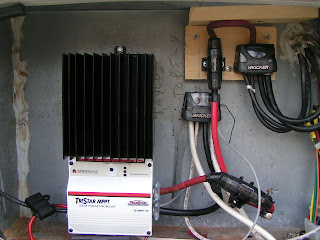First we decided, rather than go with the recommended 2000 watt inverter/charger, to wait on the inverter and upgrade our Iota DLS 45 by purchasing and installing an IQ4 Smart Charger. This little thing costs around 40 bucks and plugs into the Iota, turning it into a three stage charger. We'll use the 400 watt Modified Square Wave inverter for some of our electrical needs until we see how much we miss certain 120 volt things. So on to the project.
We ordered
3- Kyocera 135 watt pv panels. These seem popular, reasonably priced and fit our space quite well, we actually have room for one or maybe two more up there.
1 - Morningstar TriStar 45 Charge Controller with remote meter (ordered separately)
3 - 12 V AGM batteries from Batteries plus.
We ordered from Northern Arizona Wind and Sun and they advised us on extra cables, mounts, fuses, etc. that we might need.
Well the parts came in and I nervously began;
First the panels on the roof. I decided to pre-drill the holes (one per mount and four mounts per panel) and then put dicor between the mount and the hole I drilled, then put the #14 x 1in Stainless Steel screw in place and tightened down. I added another shot of dicor on top of the screw after it was in place. I ran the cables underneath the panels, I think that before I roll down the road, I'll zip tie the cables to the mounts on one side of the panels just to keep it from moving too much.
Here are some pics:
I left the Styrofoam packing material on the panel to protect them.
Here they are 415 watts of power.
For cabling from the roof, I just looked at it for two days, and then as I was getting ready to install the TriStar, I noticed those nifty channels coming down from the roof on the left and right side of the coach. I put a hole on the inside of the top of the channel, shoved the wires down and then took the bottom channel off and drilled through and snaked the wires to the site of the battery before the install. Looks great and worked like a champ. I put dicor at the sites of the holes and now the spot is all sealed off proper.
Next I had to pull the battery from the battery box as we're relocating the three batteries in the back storage compartment just about two feet from the old battery site. Here are some more pics with explanations.
Here you can see where the old battery was. Three wires hooked to the ground and four to the positive side. How to get all those wires to the new battery location.
Here's a closer view.
I removed the battery, and you can see two Kicker junction boxes purchased from a local auto audio shop. They worked great. I also got the fuse from there. The positive terminal block and fuse are mounted to wood as some extra insulation between the metal box and the current. The negative terminal block was mounted to the metal wall and into the wood behind. The hole where wires run through goes directly into the storage bin behind where the batteries are mounted. So for the first stage I just used the terminal block to move the battery location, one 4 AWG wire each going from the junction block to the battery bank. The battery bank has 2 / 0 wires running between batteries. Later you'll see I have 2 awg wire running from the charge controller (the TriStar) to the batteries.
Here is the TriStar connected I ran the positive line from the controller to the batteries through a 60 amp fuse, and fuse block purchased from the same auto audio store.
I have a few more things to do now, but we're charging batteries. I've got to put the remote meter in place, but I'm monitoring the charging from the couch.














No comments:
Post a Comment